Please use this identifier to cite or link to this item:
https://hdl.handle.net/11681/2400| Title: | Control of reactive carbonate rocks in concrete |
| Authors: | United States. Army. Office of the Chief of Engineers Buck, Alan D. |
| Keywords: | Aggregates Alkali-aggregate reactions Carbornate rocks Concrete aggregates Concrete strength Concrete test specimens |
| Publisher: | Concrete Laboratory (U.S.) Engineer Research and Development Center (U.S.) |
| Series/Report no.: | Technical report (U.S. Army Engineer Waterways Experiment Station) ; C-75-3. |
| Description: | Technical report Abstract: The effects of using reactive carbonate rocks as concrete aggregates were evaluated in a laboratory investigation. Three reactive carbonate rocks, each producing a different manifestation of the alkali-carbonate rock reaction in concrete, were each used at three dilution levels, one with low-alkali and two with high-alkali portland cements, to make concrete specimens that were tested for length changes for 3yr in a moist environment, and for compressive and tensile strengths to 1 yr. strength was extended to 3 yr. A carbonate rock and a granite gneiss were also used as coarse aggregates in other concrete mixtures to serve as controls. The same carbonate rock was used as fine aggregate in all the concrete mixtures except the three that contained gneiss coarse and fine aggregates. In addition, the expansion of samples of the reactive rocks was measured in 1 N sodium hydroxide solution. Petrographic examinations and examinations with a scanning electron microscope were made of rock and concrete samples. The detection procedure and control criteria of Appendix C of the Standard Practice for Concrete for potentially reactive carbonate rocks intended for use as concrete aggregates were considered for validity in view of the laboratory results. The laboratory findings were as follows: (a) Each reactive aggregate did create the intended reaction in the concretes containing them. (b) The negative rim-forming calcitic Pixley rock is not expansive in alkali solution, and its reaction in concrete does not result in any detectable effects on the volume or strength of concrete specimens. (c) The siliceous rim- forming dolomitic Rapid rock that was used is slowly expansive in alkali solution; normal- sized rock specimens require more than 6 months to show expansion, but larger specimens start expanding much sooner. Comparison shows that this Rapid rock is less reactive than the well known Rapid rock from the Glory Quarry. (1) There was no detectable effect of the reaction of the rock on the volume of concrete specimens. (2) Concrete specimens containing this rock failed to show a normal gain in compressive strength to an age of 1 yr. Efforts to determine whether this effect extended beyond 1 yr were not successful. There was no detectable effect on splitting tensile strength values. (3) Since the effect on compressive strength was not influenced by the alkali content of the cement, it is suggested that the strength effect may not be due to the reaction of the rock. The fact that the present test results are similar to those found by others for the more reactive rock from the Glory Quarry also suggests that differences in the reactivity of the rock do not influence the strength behavior of concrete. It is suggested that the high porosity of the rock may lower its strength so that it does not carry its proper load in concrete specimens during strength testing. (d) The reactive 1- 8 rock was rapidly expansive in alkali solution, and its use in concrete did cause expansive volume change. There was no detectable effect of the reaction on the strength of concrete specimens. As expected, the amount of volume change of concrete specimens was directly related to the amount of 1- 8 rock and the alkali content of the cement used. These results were consistent with other data. (e) There was a tentative indication that the amount of concrete expansion was also related to the amount of C3A that was in the cement used. (f) The expansions of rock specimens stored in alkali solution are 15- 20 times the expansions of concrete specimens of the same ages that are stored moist. The test data indicate that the numerical values used in Appendix C are satisfactory without change. It is recommended that Appendix C be modified to permit optional testing of potentially reactive rocks in concrete when this seems desirable. |
| Rights: | Approved for public release; distribution is unlimited. |
| URI: | http://hdl.handle.net/11681/2400 |
| Appears in Collections: | Technical Report |
Files in This Item:
| File | Description | Size | Format | |
|---|---|---|---|---|
| TR-C-75-3.pdf | 9.96 MB | Adobe PDF |  View/Open |